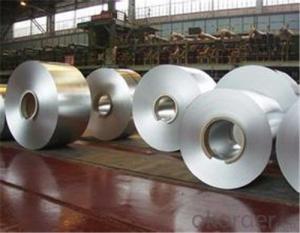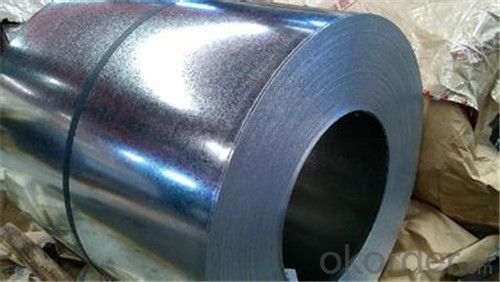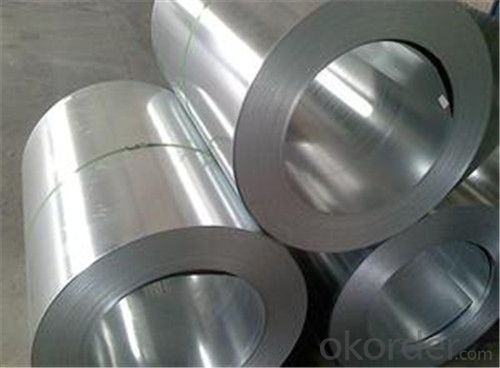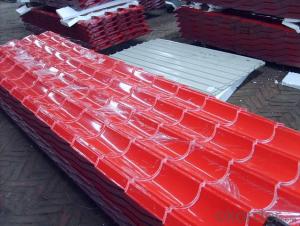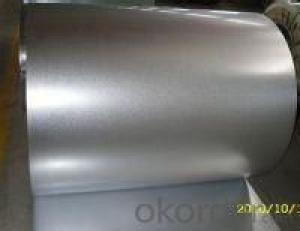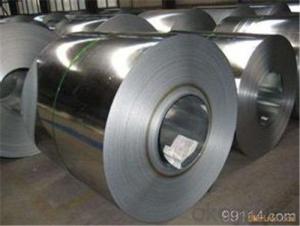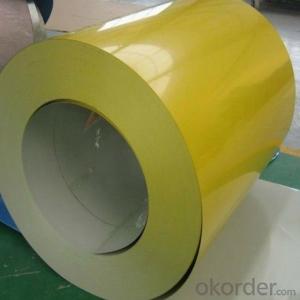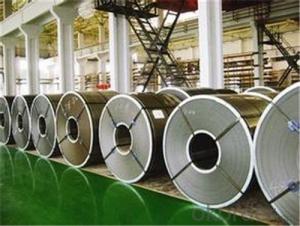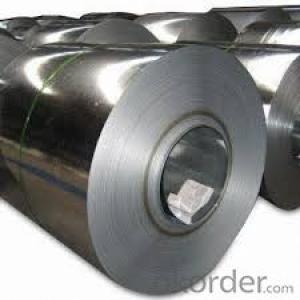Galvanized/ Auzinc Steel -SGCC in China from CNBM
- Loading Port:
- Tianjin
- Payment Terms:
- TT OR LC
- Min Order Qty:
- 150 m.t.
- Supply Capability:
- 5000000 m.t./month
OKorder Service Pledge
OKorder Financial Service
You Might Also Like
Description:
Hot-dip aluzinc steel sheet is substrated on cold rolled steel (CRC) in various strength and specification. Coating composition is 55% aluminum in weight ratio, 43.4% zinc, and 1.5% silicon, with excellent corrosion and heat resistance performance.
Specifications:
1.Mateials:SGCC,DX51D / DX52D /S250,280GD
2.Size:width:600-1250mm(900mm,1215mm,1250mm,1000mm the most common)
thickness:0.15-2.0mm
length:1000-6000mm,as your require
3.Zinc coating :60-180g( as required)
4.Coil id:508mm
5.Coil weight: 3-5MT(as required)
6. Surface:regular/mini/zero spangle, chromated, skin pass, dry etc.
Applications:
Galvalume Coil widely used for roofing products, It is also the ideal base material for Prepainted Steel Coil.
1. roofing
2. gutters
3. unexposed automotive parts
4. appliances
5. furniture
6. outdoor cabinetry
Images:
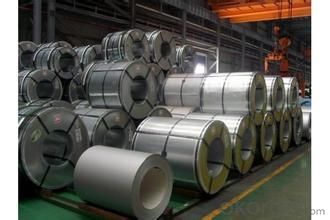
Production of cold formed corrugated sheets and profiles for roofing, cladding, decking, tiles, sandwich walls, rainwater protective systems, air conditioning duct as well as electrical appliances and engineering.
FAQ
1.What's your MOQ?
50MT, it is for one container.
2.Whether your company have QC teams?
Yeah, sure, our QC team is very important, they will keep the quality control for our products.
3. What's your normal delivery time?
Our delivery time about 10-20days for standard sizes, if you have other requirements like hardness and width ,it is about 20-40days. But don't worry ,we also try our best for the
- Q: What are the main characteristics of galvanized steel coils?
- The main characteristics of galvanized steel coils include high corrosion resistance, durability, and a shiny, metallic appearance. Galvanized steel coils are coated with a layer of zinc, which acts as a protective barrier against rust and other environmental factors. This coating also enhances the strength and longevity of the steel, making it suitable for various construction and manufacturing applications. Additionally, galvanized steel coils have excellent formability, allowing them to be easily shaped and fabricated into different products.
- Q: On how to reinforce steel coils in a container
- In the bottom and sides with a thick strip stuck, but also to ensure that the wood will not loosen down...... Rough steel rolls, I saw people loading and unloading on the docks, poked them directly with a small forklift truck, and then reinforced with wooden planks
- Q: I want to save water $$, so I want to use frozen steel to cool my coke. possible or no?
- Hey man, don't you think it would save more $$$ to cool your coke in the fridge than trying to cool steel? How do you plan on cooling the steel? And you can't freeze steel but you can make it cold. You are just joking right, I hope so anyway?
- Q: Can steel coils be coated with magnetically attractive materials?
- Yes, steel coils can be coated with magnetically attractive materials.
- Q: does regular steel rust? or is it all the same.
- Dear, Thank you, am also fine like you then dear yeah is the same.
- Q: What are the dimensions of steel coils used in the pipeline industry?
- The specific application and requirements play a significant role in the variation of dimensions for steel coils utilized in the pipeline industry. Generally, the dimensions for steel coils used in this industry fall within the range of 0.5 to 3.0 inches in thickness and 24 to 60 inches in width. The length of the coils can also vary, with standard lengths typically falling between 100 and 200 feet. These dimensions are carefully chosen to ensure the necessary strength and durability for pipeline construction and the transportation of various fluids and gases. It is crucial to acknowledge that these dimensions may differ depending on the project's specifics and the standards set by the industry.
- Q: Why do we galvanise steel? Galvanised steel is steel coated with zinc.
- Keeps it from rusting. Zinc doesn't rust like steel does.
- Q: How do we use steel ?plesase answer, its for homework xxx
- Strength of metals is normally measured by the tensile strength as the main measure although this is not the only property as hardness is another big factor. Basically, iron is soft and steel is hard. Plain iron is stretchy and does not corrode quickly, whereas steel is much stiffer and corrodes more quickly. The tensile strength of cold worked iron is about half that of an average steel, likewise the hardness is about half that of steel too. Pure iron, which is rarely used, is even weaker and softer again and a bit more like softer materials like copper and aluminium. Where confusion comes in is that there is another iron - Cast Iron - which is totally different to both iron and steel. Cast iron is very hard and tough but incredibly brittle so its properties are very different.
- Q: Can steel coils be stored in a humid environment?
- Steel coils can be stored in a humid environment, but it is not ideal. Humidity can cause steel coils to rust and corrode, leading to potential damage or degradation of the steel. It is recommended to store steel coils in a dry and well-ventilated area to protect them from the negative effects of humidity.
- Q: What are the different methods of forming steel coils into sheets?
- There are several methods of forming steel coils into sheets, each with its own advantages and applications. 1. Hot rolling: This is the most common method used to form steel coils into sheets. In this process, the steel is heated above its recrystallization temperature and then passed through a series of rollers. The rollers apply pressure to the heated steel, reducing its thickness and elongating it into a sheet. Hot rolling produces sheets with a smooth surface finish and is suitable for a wide range of applications. 2. Cold rolling: This method involves passing the steel coil through rollers at room temperature. Unlike hot rolling, cold rolling does not require heating the steel. The cold rolling process results in sheets with a higher dimensional accuracy and a smoother surface finish. Cold-rolled sheets are often used in applications where precise dimensions and a polished appearance are required, such as automotive body panels and appliances. 3. Annealing and pickling: This method involves subjecting the steel coil to a heat treatment process called annealing, followed by pickling. Annealing involves heating the steel to a specific temperature and then slowly cooling it, which helps to relieve stress and improve the material's mechanical properties. Pickling is the process of removing impurities and scale from the steel surface. These steps are typically performed before hot or cold rolling to ensure a high-quality end product. 4. Galvanizing: Galvanizing is a process that involves coating steel sheets with a layer of zinc to provide corrosion resistance. The steel coil is first cleaned and then immersed in a bath of molten zinc. The zinc adheres to the surface of the steel, forming a protective layer that prevents rust and corrosion. Galvanized sheets are commonly used in construction, automotive manufacturing, and electrical appliances. 5. Electro-galvanizing: This method is similar to galvanizing, but instead of immersing the steel coil in a bath of molten zinc, an electric current is used to deposit zinc onto the surface of the steel. Electro-galvanizing offers similar corrosion resistance to traditional galvanizing but with a thinner coating. It is often used in applications where a thinner, more lightweight sheet is desired. In summary, the different methods of forming steel coils into sheets include hot rolling, cold rolling, annealing and pickling, galvanizing, and electro-galvanizing. Each method has its own advantages and is suitable for different applications based on the required surface finish, dimensional accuracy, and corrosion resistance.
Send your message to us
Galvanized/ Auzinc Steel -SGCC in China from CNBM
- Loading Port:
- Tianjin
- Payment Terms:
- TT OR LC
- Min Order Qty:
- 150 m.t.
- Supply Capability:
- 5000000 m.t./month
OKorder Service Pledge
OKorder Financial Service
Similar products
Hot products
Hot Searches
Related keywords


